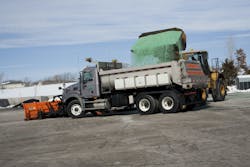Sedgwick County, Kan., stretches dollars and streamlines winter-maintenance operations
Sedgwick County, Kan., understands the benefits that come from pre-wetting salt in severely cold temperatures. Under such extreme winter conditions, the county previously used straight calcium chloride as a pre-treatment, but was beginning to discover it wasn’t the most economical choice.
“When we pre-wetted with calcium chloride it worked just fine, but we were looking for cost-cutting options that still allowed us to quickly get the roads back to normal after a storm,” said Jon Medlam, construction maintenance supervisor with the county public works department.
At the time the county began rethinking their calcium-chloride use, they also wanted to introduce anti-icing practices into their winter-maintenance services and began researching brine-making equipment at area snow conferences.
“The APWA snow conference was our starting point,” Medlam said. “We were trying to find something that was pretty simple to use, fully automated and accurate so we didn’t have to use the hydrometer all the time to check the salinity concentration.”
What they found was a state-of-the-art brine-making system that could produce approximately 5,000 gal of brine per hour right at their facility. Using a fully automated process, the system rapidly produced brine with accurate salinity concentrations all at the touch of a button.
The county also invested in an optional feature to increase system automation – a device that simplifies filling the vehicles from the brine maker. Operating 22 spreaders with 13-yd capacity plus saddle tanks and a 1,600-gal spray tank that slides into a dump truck body, an auto-fill feature suited their large-scale requirements.
Not only does the brine maker provide simpler, smoother operations, it also affords the county an increase in cost savings. Between pre-treating their 50/50 sand-salt mixture and anti-icing roadways, Medlam said making brine in-house has greatly reduced calcium-chloride use while still allowing his team to keep winter roadways safer and more passable.
“We definitely see the effectiveness of anti-icing when we apply brine before a storm,” he said. “We really get quite a bit more thawing capabilities when we pre-wet our sand-salt mix with brine, and it’s more affordable than pre-wetting with calcium chloride.”
While the brine maker can be attributed to reducing calcium-chloride use, the product is still in the mix and used in tandem with the new system. Taking advantage of yet another automated feature of the brine-making system, Medlam and his team regularly create a hot mix blend of 10% calcium chloride and 90% brine, a formula they use when temps drop below 15 degrees.
“The blended product works well,” Medlam said. “And we’ve cut down on our calcium chloride use as a result, which saves on costs.”
During their first season using the brine maker, the county batched 135,000 gal of brine to treat major thoroughfares and bridges within their territory, an area covering 685 lane-miles.
